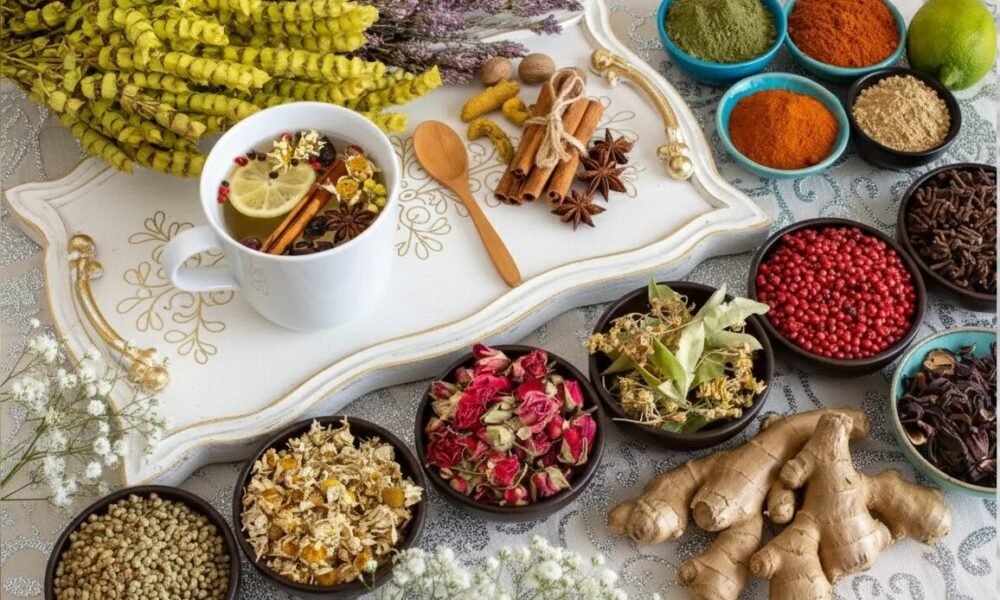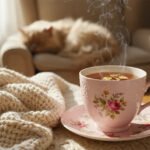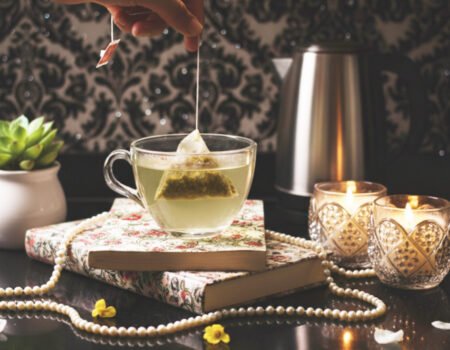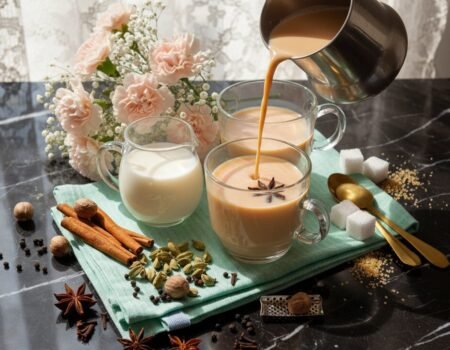
What Types of Tea Are Herbal: A Guide to Herbal Tea Varieties
Index
Many people struggle to tell apart true herbal teas from flavored versions of regular tea, making it hard to choose the right one for their needs.
Herbal teas aren’t actually teas at all in the strict sense. They come from plants other than Camellia sinensis—the source of black, green, and white teas. Instead, herbal teas (also called tisanes) are made from dried fruits, flowers, roots, and herbs like chamomile, peppermint, and hibiscus.
This guide will walk you through the most popular herbal tea types, their unique benefits, and how to spot real herbal options.
Key Takeaways
- Herbal teas aren’t true teas since they don’t come from the Camellia sinensis plant. They’re made from dried fruits, flowers, roots, and herbs instead.
- Popular herbal teas include chamomile, peppermint, ginger, hibiscus, rooibos, sage, lemon balm, rose hip, and passionflower. Each has unique flavors and health benefits.
- Chamomile tea can improve sleep continuity and quality while ginger tea can reduce nausea and menstrual cramps.
- Herbal teas may support health by promoting relaxation, aiding digestion, offering antioxidants, and in some cases supporting immune function. Limited research suggests that Echinacea tea might slightly reduce symptoms or duration of a cold.
- Most herbal teas contain zero caffeine, making them perfect for evening drinking or for people avoiding stimulants. Exceptions include Yerba Mate, Guayusa and Guarana Seeds.
What Are Herbal Teas?

Herbal teas differ from true teas because they don’t come from the Camellia sinensis plant. Instead, these caffeine-free drinks consist of dried fruits, flowers, spices, or herbs steeped in hot water.
Popular ingredients include chamomile, peppermint, ginger, hibiscus, and rooibos – each bringing unique flavors and benefits to your cup. Many cultures have used these plant infusions for centuries, both as tasty drinks and for their potential health properties.
These botanical brews often contain polyphenol antioxidants that have shown antioxidant activity in laboratory studies, potentially helping protect cells from oxidative stress. Unlike black or green tea, herbal varieties typically contain no caffeine, making them perfect for evening relaxation or for people sensitive to stimulants.
From South African rooibos to Native American Cota Navajo tea, these infusions reflect rich cultural traditions and practices from around the world.
Popular Herbal Tea Varieties

Herbal teas come in dozens of tasty varieties, each with unique flavors and benefits. From soothing chamomile to zesty peppermint, these plant-based drinks offer something for every taste preference.
Chamomile Tea
Chamomile tea comes from two main plant varieties: Matricaria chamomilla L. and Chamaemelum nobile (L.) All. This gentle flower brew offers multiple health benefits thanks to its anti-inflammatory, antioxidant, and antimicrobial properties.
Many tea lovers enjoy chamomile for its mild, apple-like flavor and calming effects. The dried blossoms steep into a golden cup that has earned recognition in medical texts across 26 countries worldwide.
A 2024 scientific review found that chamomile tea improves sleep quality and reduces nighttime waking. Earlier studies suggest it can help older adults and new mothers sleep better.
Preliminary research suggests the tea may help with blood sugar management. It might also provide relief from PMS symptoms, though more studies are needed. For stress relief, many people reach for this caffeine-free option instead of black tea or other stimulating drinks.
Peppermint Tea

Unlike chamomile’s floral notes, peppermint tea delivers a bold, refreshing flavor that many tea lovers enjoy. This popular herbal drink comes from the leaves of Mentha piperita L.
The tea contains antioxidants and natural compounds like rosmarinic acid, eriocitrin, luteolin, and hesperidin that have antimicrobial properties in laboratory studies, though their effects in the human body may be modest.
Peppermint tea shines as a natural remedy for stomach troubles. The menthol and menthone in this brew help ease indigestion, calm nausea, and can soothe irritable bowel syndrome symptoms.
Many people reach for this minty cup to settle their stomachs after meals or during minor digestive upsets. The tea’s cooling properties make it a perfect choice year-round, either hot to warm you in winter or iced for summer refreshment.
Ginger Tea

Ginger tea offers powerful flavors from its spicy root base. This warming brew can fight nausea, making it popular for morning sickness during early pregnancy and recovery after surgeries.
The tea also helps with monthly discomfort. Studies show ginger tea can decrease menstrual pain and might be helpful against dysmenorrhea.
Beyond pain relief, some preliminary evidence suggests this herbal drink might have slight protective effects on the stomach lining and might prevent ulcers. You can brew it fresh from the root or use convenient tea bags for a quick cup of this healthy beverage.
Hibiscus Tea

Hibiscus tea stands out with its bold crimson color and tart flavor similar to cranberries. This popular drink comes from the Roselle plant’s dried calyxes, creating a refreshing beverage enjoyed hot or cold.
Many people across Egypt, Mexico, and the Caribbean drink hibiscus tea daily for its pleasant taste and potential health benefits.
Research shows hibiscus tea offers more than just flavor. One 2016 study found male soccer players who drank hibiscus tea for six weeks experienced reduced oxidative stress. Limited studies suggest the tea might modestly reduce LDL cholesterol levels and blood pressure in people with hypertension.
However, pregnant women, nursing mothers, and children under 12 should generally avoid hibiscus tea as it can interfere with their sensitive hormonal balance. Tea drinkers should also note that hibiscus may interact with certain medications, particularly diuretics.
The tea contains no caffeine, making it a perfect evening drink for those sensitive to stimulants. You can enjoy hibiscus tea plain or blend it with citrus, lemongrass, or rose petals for unique flavor combinations that enhance its natural tartness.
Echinacea Tea

Echinacea tea comes from the leaves and flowers of the purple coneflower plant. This popular herbal drink stands out for its strong floral flavor and unique tingling sensation on the tongue.
Many tea lovers turn to echinacea for its potential health benefits, especially during cold and flu season.
Research suggests echinacea tea might modestly reduce the risk of upper respiratory infections or shorten cold duration by approximately one day in some people. The evidence shows small but potentially meaningful effects, though results vary between studies. The plant contains active compounds that might stimulate immune cell activity and reduce inflammation in the body.
You can find echinacea tea as loose leaves, in tea bags, or as part of advertised immune-boosting blends. For best results, steep the tea for 5-10 minutes to extract its flavorful properties.
Ginger tea offers another excellent option for those seeking herbal remedies with warming properties.
Rooibos Tea

Rooibos tea comes from a red bush native to South Africa’s Western Cape region. This caffeine-free drink offers two main varieties: red rooibos (oxidized) and green rooibos (unoxidized).
Scientists have found several health benefits in this bush tea. Preliminary research suggests it might help with allergies and bone health benefits through effects on osteoclast formation—though both findings need additional research. Early studies also hint at possible cardiovascular benefits, including modest effects on blood pressure and cholesterol.
Many tea fans enjoy its sweet, nutty flavor without needing to add sugar. The red variety has a deeper taste, while green rooibos offers a milder, grassier profile. This South African shrub belongs to the Fabaceae family and makes a perfect evening drink since it won’t keep you awake.
Sage Tea

While rooibos offers a naturally sweet profile, sage tea brings a completely different flavor experience to your cup. Sage tea comes from the leaves of the sage plant and delivers an earthy taste with subtle minty notes.
This herbal brew has gained attention for its potential brain benefits. Preliminary studies suggest it might support cognitive function in people with Alzheimer’s disease, while limited research indicates possible memory benefits in healthy adults—though more robust trials are needed. One clinical trial from 2016 found sage helped reduce LDL cholesterol in people with type 2 diabetes, but this finding requires replication in additional studies.
Many tea drinkers enjoy sage tea both for its unique flavor profile and these potential health advantages. You can brew it alone or mix it with other herbs like lemon balm for a more complex taste experience.
Lemon Balm Tea

Lemon balm tea comes from dried leaves of the lemon balm plant, offering a bright lemony flavor that many tea drinkers enjoy. This herbal infusion belongs to the mint family but delivers its own unique citrus notes.
Tea makers create this beverage by steeping the dried leaves in hot water, releasing both flavor and beneficial compounds.
Research supports several health benefits of this herbal tea. One 2017 study found lemon balm tea improved arterial stiffness, potentially benefiting cardiovascular health. The tea may increase certain antioxidant enzyme levels, based on limited evidence. Many people report calming effects and use it for mood support though clinical evidence for anxiety and depression relief remains preliminary.
Traditional uses of lemon balm tea focus on digestive health and sleep quality. The tea helps soothe upset stomachs and reduces bloating after meals. People who struggle with insomnia often turn to this herbal remedy before bedtime.
Its gentle sedative properties promote relaxation without the caffeine found in true teas. Rose hip tea offers another caffeine-free option with different health benefits.
Rose Hip Tea

Rose hip tea comes from the fruit of rose plants and packs a nutritional punch. This bright red brew contains high amounts of vitamin C and powerful anti-inflammatory compounds. Many tea lovers enjoy its tangy, slightly sweet flavor that offers both taste and health benefits.
Limited research suggests rose hip powder might help reduce some symptoms in people with rheumatoid arthritis and osteoarthritis. Preliminary evidence hints at possible weight management benefits, but the research on BMI and belly fat reduction is still in early stages and requires confirmation.
The tea works well both hot and cold, making it versatile for any season. You can find rose hip tea as a standalone beverage or blended with other herbs for enhanced flavor profiles.
Next, we’ll explore passionflower tea, another calming herbal option with unique properties.
Passionflower Tea

Passionflower tea offers a pleasant floral and grassy flavor profile that many tea enthusiasts enjoy. This calming brew has earned popularity for its traditional use in easing anxiety and improving sleep quality.
Limited scientific research provides some support for these traditional uses, with one study finding passionflower extract helped people with insomnia and one earlier study found it reduced anxiety during dental procedures.
Many tea lovers blend passionflower with other herbal infusions to create custom beverages that enhance its natural properties. The plant grows naturally in parts of the United States and Central America, making it accessible for many tea gardens.
This caffeine-free option provides a gentle alternative to traditional teas while delivering meaningful health benefits. Next, we’ll explore the various health advantages that herbal teas offer beyond just their delightful flavors.
Health Benefits of Herbal Teas
Herbal teas offer a range of health benefits backed by both science and tradition. These plant-based brews can help your body in many ways beyond just tasting good.
Promotes Relaxation

Many herbal teas offer natural ways to calm your mind and body after a long day. Chamomile tea stands out as a popular choice for better sleep quality and relaxation. Chamomile tea contains compounds that may have mild sedative effects based on preliminary research. While many tea drinkers report feeling more peaceful after drinking chamomile, individual responses vary.
Peppermint and ginger teas provide different paths to relaxation through physical comfort. Peppermint tea soothes digestive troubles that might keep you tense or uncomfortable. Ginger tea tackles discomforts like nausea or menstrual pain that prevent full relaxation.
The warm, spicy notes of ginger tea may provide a comforting sensory experience, and it might slightly reduce stress.
Passionflower tea has shown promise in preliminary research for anxiety support. Limited studies suggest this tropical plant’s brew might help with relaxation and mental calmness, possibly through effects on neurotransmitters, though more comprehensive clinical trials are needed.
For maximum relaxation benefits, try these teas about an hour before bedtime in a quiet space free from screens and noise.
Improve Immunity

Laboratory studies suggest Echinacea tea may influence immune cell activity, though the clinical significance of these effects remains under investigation. People in the Southwestern United States, including the Zuni people, have used this remedy for centuries.
Ginger tea contains gingerol as its active ingredient and has shown anti-inflammatory and antimicrobial properties in laboratory studies. While traditionally used for immune support, clinical evidence for preventing infections in humans remains limited.
Hibiscus tea contains vitamin C, which plays a role in immune function, though the amount and bioavailability from tea consumption varies.
The immune system also benefits from the support of lemon balm and rose hip teas. Lemon balm has shown antiviral activity against certain pathogens in laboratory studies, though more clinical research in humans is underway.
Rose hips contain more vitamin C by weight than oranges, potentially contributing to immune system support, though the actual amount obtained from tea depends on preparation methods.
These herbal options provide caffeine-free alternatives to traditional teas while supporting your body’s natural defenses. Next, we’ll explore how herbal teas support digestive health through their unique plant compounds.
Supports Digestive Health

Several herbal teas offer natural relief for common stomach issues. Peppermint tea works wonders for indigestion, nausea, and stomach pain thanks to its soothing properties. Ginger tea stands out as a powerful remedy against nausea, making it helpful for morning sickness in early pregnancy and for patients recovering from surgery.
Traditional use and limited studies suggest both chamomile and lemon balm teas may help with digestive comfort – chamomile for general gastrointestinal discomfort and lemon balm for digestive function, though more clinical research is needed to confirm these effects.
These plant-based brews provide gentle support without the harsh side effects of some medications. Laboratory and limited clinical studies suggest the active compounds in these herbs may help reduce inflammation and promote digestive muscle relaxation, though more research is needed to fully understand these mechanisms in humans.
Many people find that a warm cup after meals helps food move through their system more comfortably. Beyond just settling your stomach, these teas can become part of a daily ritual that promotes overall wellness and health.
Rich in Antioxidants
Herbal teas are rich in antioxidants, particularly polyphenols, which help protect cells from damage by neutralizing harmful free radicals.
Many tea varieties like hibiscus and rooibos contain high levels of these beneficial substances provide antioxidant activity that may contribute to overall health, though direct evidence for preventing specific diseases like cancer and heart disease through herbal tea consumption remains limited and requires long-term studies.

Tea drinking offers a simple way to boost your daily antioxidant intake without medication. The polyphenols found in chamomile, peppermint, and other herbal infusions provide protection at the cellular level where it matters most.
Next, we’ll explore which herbal teas contain no caffeine for those seeking a completely stimulant-free option.
Herbal Teas Without Caffeine
Most herbal teas lack caffeine completely. Unlike black, green, or oolong varieties that come from the Camellia sinensis plant, herbal infusions use flowers, roots, and leaves from other plants.
This makes them perfect choices for evening drinking, pregnancy, or anyone avoiding stimulants. Popular caffeine-free options include chamomile for sleep, peppermint for digestion, and rooibos for its sweet flavor profile.
Many tea drinkers switch to herbal options to reduce their caffeine intake while still enjoying warm, flavorful drinks. Hibiscus tea offers a tart, cranberry-like taste while providing antioxidants.
Lemon balm creates a gentle citrus flavor that calms nerves. Ginger tea delivers spicy warmth that aids stomach issues. These caffeine-free alternatives work well both hot and cold, making them versatile drinks for any time of day.
Conclusion

Herbal teas offer a world of flavors and benefits beyond traditional tea leaves. From soothing chamomile to zesty peppermint, these plant-based brews provide caffeine-free alternatives for any time of day.
While scientific research continues exploring the full potential of herbal teas, early studies show promising results for various wellness benefits. You’ll find that each variety offers its own possibilities—chamomile may promote relaxation, peppermint could ease digestion, and echinacea might support immune function slightly.
As researchers work to confirm these traditional uses, you can enjoy discovering new flavors and have fun experimenting with different varieties and combinations.
Next time you reach for a hot drink, consider the rich variety of herbal options waiting to delight your senses and nourish your body.
For those interested in exploring more about caffeine-free beverage options, be sure to check out our article on herbal teas without caffeine.
FAQs
1. What makes a tea “herbal”?
Herbal teas aren’t true teas at all. Unlike black, green, or oolong teas which come from the tea plant (Camellia sinensis), herbal teas are made from dried fruits, flowers, spices, or herbs. They’re usually caffeine-free and often brewed for their unique flavors and traditional medical benefits.
2. Which popular plants are used to make herbal teas?
Lavender (Lavandula), chamomile, peppermint, and roselle are common herbal tea ingredients. Butterfly pea flower tea from Southeast Asia creates a stunning blue liquor that changes color with citrus. Many herbs like valerian root are valued in folk remedies across Europe and Asia.
3. Do herbal teas contain caffeine?
No. Most herbal teas contain no caffeine since they don’t come from the tea plant. This makes them perfect evening drinks. Some exceptions include yerba mate or guayusa, which contain caffeine.
4. Can herbal teas help with stress?
Many people drink herbal teas to reduce stress. Valerian and chamomile are particularly known for their calming properties. These natural options have been used for centuries as folk cures for anxiety, though their effects vary from person to person.
5. How are fruit teas different from other herbal teas?
Fruit teas are a subset of herbal teas made with dried fruits like orange, apple, or berries. They are typically sweet without needing additional sugar. Unlike leaf-based herbal infusions, fruit teas often have tangier profiles that make them popular choices for iced tea and summer beverages similar to lemonade.
6. What indigenous herbal teas exist in North America?
Native species used by indigenous peoples include yaupon tea from the holly family, once consumed by Hopi tribes. Mormon tea, made from ephedra, grows in New Mexico and Colorado. These traditional brews reflect the rich botanical knowledge of North America’s original inhabitants and offer alternatives to imported varieties.
References
- https://artfultea.com/blogs/wellness/types-of-herbal-tea-and-their-benefits?srsltid=AfmBOoqqLYGoq-iAveVcQU3tLAER2euT_Wj7CZZ7IXbWH_-n3nIjdsSf
- https://www.healthline.com/nutrition/10-herbal-teas
- https://pmc.ncbi.nlm.nih.gov/articles/PMC9822300/
- https://artfultea.com/blogs/wellness/types-of-herbal-tea-and-their-benefits?srsltid=AfmBOopmyHNo6Jd_tPLqJNzKMieQAC_x29XRXcVcPdP2Ju4T2p2PG-yc
- https://pubmed.ncbi.nlm.nih.gov/16767798/
- https://artfultea.com/blogs/wellness/types-of-herbal-tea-and-their-benefits?srsltid=AfmBOooeXnhK1OgsfO7uCtKy1Ng24rkcVzsir34kxG4Xy8Go4j5ZV6Jh
- https://www.researchgate.net/publication/287478165_Review_on_herbal_teas
- https://teapigs.com.au/blogs/blog/types-of-herbal-tea?srsltid=AfmBOooOIcHn8Lg0nmhTPQvrU55azivh39nJ2f2_9nW-klbxxm3CPDnF
- https://teapigs.com.au/blogs/blog/types-of-herbal-tea?srsltid=AfmBOopWvuhdsDbTcQbt4gY82dXGcwZ8tKAaB9S-cBGuoouY9QLY3wIY
- https://senchateabar.com/blogs/blog/echinacea-tea?srsltid=AfmBOopexGxWaDCyDk-pNc9Dr-A1vtKgsJ8DzlaVkmJb8t5PGqjcRUb9
- https://www.whittard.com/discover/tea-tips/a-guide-to-rooibos.html
- https://artfultea.com/blogs/101/types-of-tea-a-comprehensive-guide?srsltid=AfmBOopD2ytVIGm7cMFG_Ey7ta3-pC0ctOpVulTns297-0SUv0HtPElU
- https://teapigs.com.au/blogs/blog/types-of-herbal-tea?srsltid=AfmBOorcnhi5rQBDxyaQBjjT8X6A21QEpjMNcAyu9KbD0GNvwqr3fT7n
- https://www.medicalnewstoday.com/articles/lemon-balm-tea
- https://livezesty.com/blogs/zest-blog/types-of-herbal-tea-a-comprehensive-guide?srsltid=AfmBOoolCZ1jyoYi74c8MC6Ero8eYfG2f9wdGfb1ZDgQMGQx2WnIo30_
- https://www.health.harvard.edu/nutrition/the-health-benefits-of-3-herbal-teas
- https://www.ncbi.nlm.nih.gov/books/NBK92768/
- https://artfultea.com/blogs/wellness/types-of-herbal-tea-and-their-benefits?srsltid=AfmBOoo8plMp1WY7Yq2jtEwYWnbRg3lFgTmrmRMcGH8h5rCvrOp_1-B1
- https://pmc.ncbi.nlm.nih.gov/articles/PMC11521711/
- Examine.com






